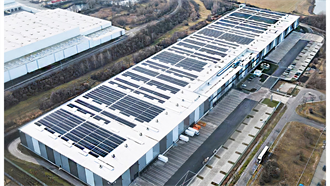Industrial landlords are keen to plug into the growing data centre market across Europe, as a sub-class of essential urban infill schemes emerges.
While the shift online of large parts of our daily lives has had a negative impact on major asset classes including retail and offices, other property types are flourishing. Data centres are one of the benefactors of the seemingly unstoppable digital megatrend, propelled by everything from soaring e-commerce volumes to increasing internet of things (IoT) applications.
In 2020 alone, take-up in Europe’s main data centre markets of Frankfurt, London, Amsterdam, Paris and Dublin (Flap-D) increased 22% year-on-year reaching 201.2 megawatts (MW), with this pace of growth expected to continue for the rest of 2021, according to JLL data.
This year alone, some 438 MW of new supply is likely be added to the Flap-D markets, a 21% increase on the total market size. Notes Jonathan Kinsey, head of EMEA data centre services, at JLL: ‘Widespread lockdowns, social distancing, and home-based working have transitioned many everyday activities from the physical to the digital.
This has boosted demand for digital infrastructure, including data centres, with many organisations needing to accommodate elevated consumer demand and expectations like never before. The growth of Europe’s data centres will continue to accelerate, largely driven by hyperscalers and technology players and we project that take-up will rise by around a third in 2021.’
Investor interest
It’s unsurprising that industrial landlords and land owners are now looking to get in on the act, attracted too by the lengthy lease terms that operators are prepared to sign. Occupier capex is so significant that tenants are usually at ease with inking 25-year leases, which make for compelling covenants. Unlike other industrial assets, the upper floors of multi-storey data centres command the same rents as ground floor spaces, as servers and IT equipment don’t require the same through traffic as logistics operations.
Kinsey notes that property owners are often keen to propose their own industrial assets to potential occupiers who are active in the market. However, few vacant sheds or land plots are suitable for data centre occupancy, due to increasingly detailed specifications for these asset types. ‘Today’s data centres need large plots served by excellent infrastructure, namely reliable and resilient power, and cable-linked fibre. Operating 24/7, they need to be shielded from natural risks including flood and earthquake risks. But the most important factor of all is location, as they need the infrastructure as well as proximity to the cities they serve for reasons of latency,’ he says.
In fact, despite their digital dimension, the physical location of data centres is crucial to their success and is set to become ever more essential as edge computing, which is highly distance sensitive, increases in importance. Other jurisdictional factors may also come into play. Social media giant TikTok recently unveiled plans to build its first ever data centre in Europe, a $500 mln scheme to be located in Ireland, to better handle local data flows and tackle privacy concerns.
‘Last-mile’ data centres
These themes converge in a wider trend focusing on taking the infrastructure to the client in the age of edge computing, which demands that data is processed and analysed closer to the point of its creation. The latest bricks and mortar response is a kind of ‘last mile’ data centre, an emerging asset sub-class, serving towns and cities of all sizes.
These smaller assets, dubbed edge deployment centres, often seek out ‘hyper-local’ urban infill locations to provide faster network responses to customers in the search for an ever lower-latency response. They are primed to deliver critical business services with response times of 5-7 milliseconds, and also support bidirectional data precipitated by IoT devices and 5G cellular networks. Their geographical sensitivity is thus likely to activate Tier 2 markets beyond the major cities for colocation centres.
Says Kinsey: ‘There’s a lot of investment and strategic planning happening now around the deployment of edge networks, so it’s definitely a trend to watch. Data centre owners will be looking at if they can add these critical assets to their existing portfolios, and what kinds of opportunities might open up in urban locations – could you add one to a retail park site for example?’
Green challenge for data centres
The data centre market is also facing another formidable test: the sustainability challenge. As part of the European Green Deal, the European Commission has declared that data centres should be carbon-neutral by 2030, with new data centres required to have a power usage effectiveness of 1.2 or lower, and existing ones to not exceed 1.3. In parallel with this, corporations are increasingly focused on their own carbon footprint, and see an opportunity in data centres to tick some green boxes.
Spain’s Merlin Properties recently decided to address the matter through teaming up with sustainable energy group Edge Energy as it takes its first steps in the sector. The two companies plan to build a network of ultra-efficient, waterless data centres in major Spanish cities, using Merlin’s existing land bank. ‘This solution clearly gives them an advantage over the rest of the market,’ suggests Stephen Beard, co-head of Knight Frank’s data centres team.
Continued innovation in these areas will be key, with district heating initiatives in cities such as Amsterdam and Stockholm successfully siphoning off some of the heat that data centres generate. In Scotland, Microsoft has trialled underwater data centres, finding much lower server failure rates than its on-land servers. But there is still much to be done.
‘Data centres that are carbon neutral do exist – but there are lots of assets which still aren’t,’ Kinsey notes. ‘New developments are taking into consideration energy procurement strategies, alongside construction materials and water use in a much more focused way. But the sustainability aspects cannot be solved by landlords or occupiers alone. There will need to be significant partnerships across municipalities, energy companies, developers and landlords to really make a difference,’ Kinsey concludes.



































